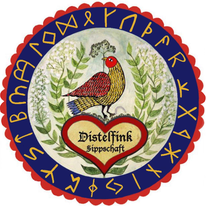It is now mid-December, and the Yuletide is coming upon us quickly. The first observance in the Deitscherei that is directly related to the Yuletide is the coming of der Belsnickel.
Typically, Belsnickel is viewed through the post-conversion lens of St. Nicholas, much like Santa Claus is. The translation of the name itself, "fur Nick" or "Nicholas in furs," reflects that image. However, is St. Nicholas really the character from whom either Belsnickel or Santa Claus comes?
The case against St. Nicholas is fairly simple. There is no reindeer in Anatolia; the North Pole, Elves, Yuletide, and the sleigh ride through the skies with "Mrs. Claus" (a.k.a. Holle) with all sorts of other spirits present (read: Wild Hunt), and numerous other references give the major clues to the true origin of both entities.As has been pointed out on other Heathen, including Urglaawe, sites, an argument can be made that the Heathen origins of Belsnickel/Krampus and Santa Claus reflect two aspects of the same deity (Wudan, Wodan, Wotan, Odin).
The classic features of der Belsnickel are still visible in some areas of the Deitscherei today, but, in most places, they have shaped him into a more innocuous figure than in prior generations. Typically, Belsnickel appeared anytime in mid-December (not just at the Church-appointed St. Nicholas Day, the date of which may be part of the reason that St. Nicholas was chosen as the saint to diminish the god). He would arrive, looking haggard, dirty, frightening, and dressed in pelts. Whether he had horns or not seemed to depend on locality; those that I remember did not, but plenty of other people in the region relate the presence of horns.
Belsnickel would ask arcane riddles, many of which actually had a simple answer. He actually allowed a fair amount of time for an answer. In fact, I remember him encouraging children to work together in order to solve certain riddles. However, each child was ultimately responsible to provide an answer for the riddles on his or her own. If the child answered incorrectly, or not at all, he or she had to vie for a horse chestnut against other children who did to answer correctly. There was always one less horse chestnut than there were children. As the children were trying to grab a chestnut, Belsnickel would take swats at their hands with a switch. Whichever child ended up with no horse chestnut took a whack on the butt from the switch.
The other children had proven their worthiness in "battle" by winning a horse chestnut and were prepared for Santa Claus' gifts, and while the whack on the butt was certainly terrifying for the victim, it also resulted in the complete exoneration of the child from any wrongdoing, including not being able to answer the riddle. I suspect, however, that in the distant past, that the representation of the whipping had more negative implications.
Wudan, as der Belsnickel, is the shady Seeker, who rewards wisdsom and punishes ignorance. He also presents the dark side of life and teaches us to use our intelligence and skill to deal with it. Wudan, as Santa Claus, reveals His Wish-Granter aspect. Here he projects the joys of life, the concept of generosity, and the social gains to be made through gift exchange. These aspects represent a balance and an understanding of life in a variety of contexts that can help a community face the dangers of life while also recognizing and actualizing love, joy, etc.
The intense hyper-marketing of Santa Claus and the marginalization of Belsnickel remove an opportunity for life lessons to be taught at a young age. The Consumer Culture Christmas has created a bubble around children in an attempt to shield them from the realities of life. Everything has to be "perfect," and the dark side of real life is allowed only in the context of video games, where violence is simultaneously bred and undone by restarting the game. This bubble, ultimately, does the children a disservice.
Our children see acts of violence everywhere, especially in their games. The answer in those games to solving and avoiding violent issues, however, is always more violence. Using ones wit or coming together as a community for mutual benefit is, as far as I know, generally absent from computer games. On the one hand, we have a bubble shielding children from outside violence. On the other hand, we have the violence -- and a skewed way of responding to challenges -- taking a special, invitation-only place within the home.
Our ancestors were often much wiser than we think. Fairy tales and replications of deity actions often served as lessons for the children in how to deal with real life. These are lessons that are projected by Belsnickel, or the Krampus, today.
Wednesday, December 12, 2012
Subscribe to:
Posts (Atom)

